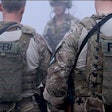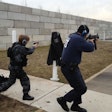Judging by readers’ comments, last week’s SWAT column, “Who’s in Charge?” struck a responsive cord with a number of you. Here are some of your comments:
• One retired SWAT commander described how early incident commanders were patrol shift commanders, often with limited tactical experience. The constant was that once a situation went “tactical,” the SWAT Commander was now in charge. Eventually, Incident Command Staff teams were created consisting of commanders with proven decision-making abilities, familiar with SWAT and HNT.
• One reader recommended a return to the “green light” days, where once a situation was turned over to SWAT, the SWAT commander was in charge of tactics.
• A SWAT officer asked how someone in SWAT can help change the trend of SWAT micromanagement at critical incidents.
• Another reader recommended that SWAT should have a senior lieutenant in charge. This is how the military works in Iraq and Afghanistan, where lieutenants have more authority, capability, and responsibility than domestic SWAT.
To be effective an Incident Command System (ICS) requires proper design, staffing, and administration. This means that you need commanders with knowledge of strategy and tactics who know how to utilize SWAT and CNT to resolve critical incidents smoothly and efficiently.
In-fighting between SWAT and CNT was common in SWAT’s early days, when SWAT and CNT were often pitted against each other. A number of SWAT teams resolved this by incorporating negotiations as part of SWAT. Other teams designated the SWAT commander in charge of both SWAT and CNT. Regardless of how you do it, SWAT and CNT need to work together as a team to be successful.
Although I am not a fan of “green light,” the reader makes a valid point. Once a situation is turned over to SWAT, the SWAT Commander is in charge of the tactics. The problem with “green light” is that many officers in the brass interpret it as “red light,” not allowing SWAT to act.
Micromanaging SWAT is a challenge for many teams, and sometimes the solution is to outlast the micromanagers. I recall the frustration of one SWAT commander over his chief’s micromanaging. The solution arrived when the chief finally retired, and the SWAT commander became the new chief.
The one reader has an interesting observation about military lieutenants often having more authority than their SWAT counterparts. Both are capable of running critical incidents, which tend to be isolated to a single location. Plus, SWAT supervisors are routinely given the authority to run high-risk assignments (especially raids and searches). SWAT’s track record of proven success should speak for itself. However, during hostage and/or barricade situations, many teams suddenly find themselves required to “ask permission” when it comes to decision making.
All of which begs the question of why SWAT can be trusted for some incidents, but not for others. The answer is found in the word perception, combined with the human and political factors. It’s amazing how differently some in command perceive things than we do in SWAT.
This may be due to the nature of the mission each is tasked with. SWAT focuses on the problem at hand, how to resolve the situation successfully. While command’s focus is far broader and includes not only the situation but also collateral issues such as crowd and traffic control, news media relations, and political ramifications in the community.
A striking example of how perception of the same incident is processed is seen in this example. Patrol was pinned down and engaged in a shootout with a barricaded suspect. Immediately upon arrival, SWAT deployed and shot and killed the suspect. Shortly afterward, the chief arrived and was clearly more concerned with the power outage that had knocked out all the downtown traffic signals. I seriously doubt any of the officers involved in the shooting were concerned about anything other than their survival. Very clearly, the perception gap in this incident was night and day.
In an ideal world, ICS at SWAT incidents would consist of command elements who are trained and knowledgeable in strategy and tactics and who understand how best to deploy all their tools – SWAT, CNT, Patrol, PIO, etc. But in the real world, oftentimes, ICS is still left to rank and chance instead. Too often the result is that SWAT is handcuffed or must reinvent the wheel every time it’s called out for critical incidents. Savvy SWAT commanders often find ways to work with ICS, not against it. However, in the real world, this is not always possible. Just do the best you can, and always act as the consummate professionals you are.
When our SWAT team first formed, we had numerous detractors drooling over the prospect of our first “screw up.” We knew there was zero margin for error, and a single mistake would result in the unit being eliminated. Inadvertently, instead of destroying us, our detractors made us a better, stronger, and closer team. And an interesting thing happened along the way, we earned the respect and cooperation of those who count the most: the street cops.
Ultimately, SWAT’s professionalism will prevail.












